Beans & Grains Glossary – Learn Your Legumes (And Other Family Members)Page 1: Beans & Grains Glossary A & B This is Page 1 of an 7-page article. Click on the red links below to visit other pages. This glossary is protected by copyright and cannot be reproduced in whole or part. You are welcome to link to it.
|
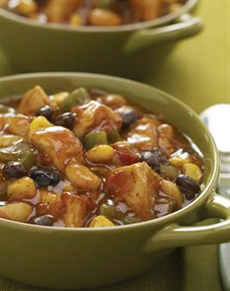 Protein-filled beans can be served as a main course or side, or mixed into favorite recipes. Get the recipe for this Jalapeño, Black Bean, Corn & Chicken Chile. Photo courtesy McCormick. |
|
|
ADZUKI or AZUKI BEAN Native to China, the adzuki beans (Vigna angularis) is a small (1/4 inch long), reddish-brown, oval bean with a thin, white stripe down the side. It grows on a bush, rather than on a vine. The bean has a nutty, sweet flavor and firm texture. This is the red bean used in Asian desserts; it also has savory uses, and can be enjoyed with rice dishes. The adzuki bean was brought to the U.S. in the mid 19th century. When steamed with rice, the bean gives the rice an attractive, slightly pink color. It is also known as the aduki, adsuki, asuki, azuki, feijao, field pea, red Oriental bean and Tiensin red.
|
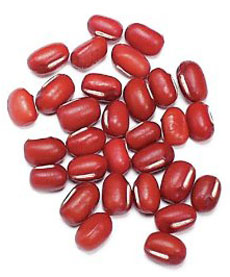 Adzuki beans, available from Amazon.com. |
|
|
AMARANTH Amaranth (Amaranthus creuntus), an 8,000-year-old crop, was food for the Aztecs and Incas, and was a significant part of the ancient Aztec empire’s agricultural base. The crop was regarded so highly that each year bushels of amaranth were presented to the emperor Montezuma. Because the crop figured so prominently in Aztec culture and religious ceremonies, the conquering armies of Cortez burned the fields to the ground. As European crops replaced indigenous ones, amaranth slowly fell out of use. Amaranth is high in protein and contains large amounts of dietary fiber , iron, and calcium as well as other vitamins and minerals. Amaranth also has naturally high amounts of lysine, methionine and cysteine combined with a balance of amino acids. These grains are round and tiny, smaller than mustard seeds. gold in color with flecks of black. It has a crunchy texture and is very chewy. Amaranth is not a true grain, but a seed from a broadleaf herb plant. |
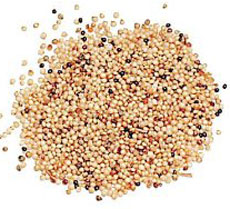 Amaranth, available at Amazon.com. |
|
|
ANASAZI BEANS Originating in New Mexico, these pretty reddish-brown beans with white markings are popular in Southwestern recipes, including soups and refried beans. When cooked, the bean becomes light beige or pink in color with a somewhat sweet taste and meaty texture. They are also known as the appaloosa bean, Aztec bean, Jacob’s cattle bean and New Mexico cave bean.
|
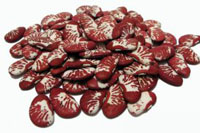 Photo by Luciano S. | SXC. |
|
|
BARLEY or PEARL BARLEY or PEARLED BARLEY Barley (Hordeum vulgare) is one of the oldest domesticated crops (there is evidence of barley in the Nile Delta more than 18,000) and one of the major cereal crops in the world (in 2005 it ranked fourth in amount cultivated—consider that it is an ingredient in beer, a drink popular worldwide). A small, spherical grain, it is grown worldwide and usually “pearled” to remove its outer bran and husk, leaving only a small white “pearl” of endosperm. Pearled barley has a slightly sweet, nutty, earthy flavor, chewy texture and high starch content. It was a staple cereal of ancient Egypt, where it was used to make bread and beer, and it was used to make beer when it was first planted in America around 1600. Barley has been accorded special status as well: The Chinese believed it increased male sexuality; in Rome, barley was the special dish of the gladiators. A new variety of barley, black barley (also known as purple hull-less barley, originally from Ethiopia, is now being raised in Montana. A specialty product, it is unprocessed; the nutritious bran layer is edible and stays attached to the kernel.
|
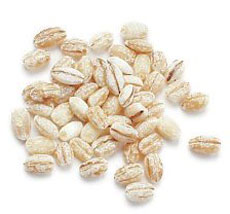 Pearled barley and black barley are available at Amazon.com. 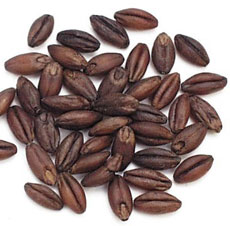
|
|
|
BEAN Bean originally meant the seed of the broad bean, but the definition was later expanded to include members of the genus Phaseolus such as the common bean or haricot and the runner bean and the related genus Vigna, which includes the mung bean, the rice bean and the black-eyed pea. The term is now applied in a general way to some 15 other genuses which include such varieties as soybeans, peas, lentils, chickpea (garbanzo), pea, lentil, lima, common bean (including the black bean, pinto bean and kidney bean), soybean and guar. Broad beans in the pod. Bean originally meant the seed of the broad bean, but the definition was later expanded to include members of the genus Phaseolus such as the common bean or haricot and the runner bean and the related genus Vigna, which includes the mung bean, the rice bean and the black-eyed pea. The term is now applied in a general way to some 15 other genuses which include such varieties as soybeans, peas, lentils, chickpea (garbanzo), pea, lentil, lima, common bean (including the black bean, pinto bean and kidney bean), soybean and guar. Broad beans in the pod.
|
 Broad bean, a.k.a. fava bean. Photo of by Rasbak Gebruiker. |
|
|
BELUGA LENTIL Beluga lentils are tiny black lentils, one of the smallest lentils, so named because they resemble beads of beluga caviar. Their beautiful color, sheen after cooking, elegant petite appearance and mild yet earthy flavor make them a favorite with leading chefs. Easy to cook, the lentils make an elegant bed for meat, poultry and seafood; a beautiful garnish; a lovely addition to soups and salads. Since they look like caviar after cooking, you can use them on canapés as well. Try hummus garnished with beluga lentils. BESAN
|
 Uncooked beluga lentils are available at Amazon.com. |
|
|
BLACK BEAN or BLACK SPANISH BEAN or COMMON BEAN or TAMPICO BEAN or TURTLE BEAN or SPANISH BEAN or VENEZUELAN BEAN A relative of the kidney bean, the black bean (Phaseolus vulgaris), or common bean, is thought to have originated in southern Mexico and Central America more than 7,000 years ago. Evidence of its use has been found in excavations of prehistoric dwellings. The common bean has since spread around the world. Black beans are small in size with a cream-colored flesh and black skin. They are used throughout Latin America, the Caribbean, and the southern United States (especially Florida and the Southwest). Black bean soups, stews and sauces are very common in Latin American countries and are an important ingredient in Brazilian and Cuban dishes. Black beans are becoming more popular in the U.S., in part due to increased immigration from Latin American countries. They are small, kidney-shaped and shiny, with a slight mushroom flavor. Black beans hold their shape when cooked and absorb flavors well.
|
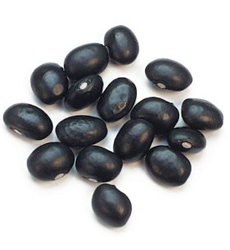 Black beans are available at Amazon.com. |
|
|
BORLOTTI BEAN Blackeyed peas (Vigna unguiculata) are medium-sized (3/8 inch long), ivory-colored beans with a large black coloration (the “eye”) on the inner curve of the beans, where they are attached to the pod. Related to the mung bean, blackeyed peas originated in Eastern Asia. They were brought to the Americas with the African slave trade, and were a staple of many plantation diets. Blackeyed peas have a sweet, mild flavor and firm texture, and absorb the flavors of a dish very well. Blackeyed peas are perhaps best known as a Southern dish, where they are often served with ham and rice. Blackeyed peas are also commonly used in bean cakes, casseroles, curry dishes, fritters and salads. Variations are yellow, brown or red in color. The bean is also known as the black eyed Suzy, brown-eyed pea, cherry bean, China pea, cowpea, frijole, Indian pea, Jerusalem pea, lobhia, marble pea and Tonkin pea. BORLOTTI BEAN
|
 Blackeyed peas available at Amazon.com. |
|
|
BULGUR or BULGHUR |
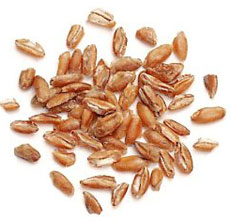 Bulgur available at Amazon.com. |
|
| Continue To Next Page: Terms With C | ||
Last Updated Apr 2018
© Copyright 2005-2025 Lifestyle Direct, Inc. All rights reserved. All images are copyrighted to their respective owners.